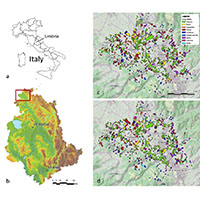Comparing Sentinel-1, Sentinel-2, and Landsat-8 data in the early recognition of irrigated areas in central Italy

Published:23 December 2021
Abstract Views: 1264
PDF: 575
HTML: 60
HTML: 60
Publisher's note
All claims expressed in this article are solely those of the authors and do not necessarily represent those of their affiliated organizations, or those of the publisher, the editors and the reviewers. Any product that may be evaluated in this article or claim that may be made by its manufacturer is not guaranteed or endorsed by the publisher.
All claims expressed in this article are solely those of the authors and do not necessarily represent those of their affiliated organizations, or those of the publisher, the editors and the reviewers. Any product that may be evaluated in this article or claim that may be made by its manufacturer is not guaranteed or endorsed by the publisher.
Similar Articles
- Daniele Masseroni, Jasim Uddin, Reece Tyrrell, Iven Mareels, Claudio Gandolfi, Arianna Facchi, Towards a smart automated surface irrigation management in rice-growing areas in Italy , Journal of Agricultural Engineering: Vol. 48 No. 1 (2017)
- Juan Ãngel Mintegui Aguirre, José Carlos Robredo Sánchez, Carlos de Gonzalo Aranoa, Pablo Huelin Rueda, Jorge Fallas, Felipe Cisneros, Pedro Cisneros, Adriana Urciuolo, Rodolfo Iturraspe, Forest use strategies in watershed management and restoration: application to three small mountain watersheds in Latin America , Journal of Agricultural Engineering: Vol. 45 No. 1 (2014)
- Meriem Er-Rami, Guido D'Urso, Nicola Lamaddalena, Daniela D'Agostino, Oscar Rosario Belfiore, Analysis of irrigation system performance based on an integrated approach with Sentinel-2 satellite images , Journal of Agricultural Engineering: Vol. 52 No. 2 (2021)
- Cesar Augusto Terán-Chaves, Sonia Mercedes Polo-Murcia, Cropping pattern simulation-optimization model for water use efficiency and economic return , Journal of Agricultural Engineering: Vol. 52 No. 4 (2021)
- Daniela Vanella, Filippo Ferlito, Biagio Torrisi, Alessio Giuffrida, Salvatore Pappalardo, Daniela Saitta, Giuseppe Longo-Minnolo, Simona Consoli, Long-term monitoring of deficit irrigation regimes on citrus orchards in Sicily , Journal of Agricultural Engineering: Vol. 52 No. 4 (2021)
- Francesco Bettella, Tamara Michelini, Vincenzo D'Agostino, Gian Battista Bischetti, The ability of tree stems to intercept debris flows in forested fan areas: A laboratory modelling study , Journal of Agricultural Engineering: Vol. 49 No. 1 (2018)
- Andrea Setti, Giulio Castelli, Lorenzo Villani, Roberto Ferrise, Elena Bresci, Modelling the impacts of water harvesting and climate change on rainfed maize yields in Senegal , Journal of Agricultural Engineering: Vol. 54 No. 3 (2023)
- Andrea Peruzzi, Luisa Martelloni, Christian Frasconi, Marco Fontanelli, Michel Pirchio, Michele Raffaelli, Machines for non-chemical intra-row weed control in narrow and wide-row crops: a review , Journal of Agricultural Engineering: Vol. 48 No. 2 (2017)
- Giuseppe Longo-Minnolo, Alessandro D’Emilio, Juan Miguel Ramírez-Cuesta, Daniela Vanella, Serena Guarrera, Giacoma Manerchia Maserà, Simona Consoli, Satellite remote sensing for monitoring citrus orchards water requirements at the irrigation district scale , Journal of Agricultural Engineering: Vol. 56 No. 1 (2025)
- Salvatore Faugno, Luisa del Piano, Mariano Crimaldi, Gennaro Ricciardiello, Maura Sannino, Mechanical oil extraction of Nicotiana tabacum L. seeds: analysis of main extraction parameters on oil yield , Journal of Agricultural Engineering: Vol. 47 No. 3 (2016)
You may also start an advanced similarity search for this article.

 https://doi.org/10.4081/jae.2021.1265
https://doi.org/10.4081/jae.2021.1265 











